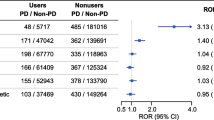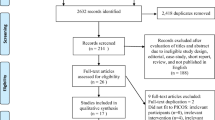Abstract
Background
Several studies have suggested that NSAID use may modify the risk of developing Parkinson’s disease (PD).
Objective
Our aim was to conduct a meta-analysis of observational studies evaluating NSAID use and the risk of PD.
Methods
We systematically searched MEDLINE (1966–November 2008), EMBASE (1980–November 2008) and other databases. Data from 11 studies were included in the meta-analysis. We used the random effects model to calculate risk ratios (relative risks) and their corresponding 95% confidence intervals (CIs).
Results
The pooled risk ratio of PD with NSAID use was 0.95 (95% CI 0.80, 1.12). The pooled risk ratio of PD with high-dose or long-duration NSAID use was 0.91 (95% CI 0.78, 1.05). The pooled risk ratio of PD for aspirin (acetylsalicylic acid) users was 1.08 (95% CI 0.93, 1.26). The pooled risk ratio of PD among ibuprofen users was 0.76 (95% CI 0.65, 0.89). The pooled risk ratio of PD in men using NSAIDs was 0.79 (95% CI 0.69, 0.92), and in women using NSAIDs, it was 0.72 (95% CI 0.45, 1.15).
Conclusions
NSAIDs as a class do not seem to modify the risk of PD. However, ibuprofen may have a slight protective effect in lowering the risk of PD. Although the risk ratios of PD in male and female NSAID users were similar, the 95% CI for men was suggestive of a slight risk reduction.







Similar content being viewed by others
References
Samii A, Nutt JG, Ransom BR. Parkinson’s disease. Lancet 2004; 363: 1783–93
Litvan I, Chesselet MF, Gasser T, et al. The etiopathogenesis of Parkinson disease and suggestions for future research: part II. J Neuropathol Exp Neurol 2007; 66(5): 329–36
Schapira AH. Mitochondria in the aetiology and pathogenesis of Parkinson’s disease. Lancet Neurol 2008; 7(1): 97–109
Beal MF. Mitochondria, oxidative damage, and inflammation in Parkinson’s disease. Ann N Y Acad Sci 2003; 991: 120–31
Monahan AJ, Warren M, Carvey PM. Neuroinflammation and peripheral immune infiltration in Parkinson’s disease: an autoimmune hypothesis. Cell Transplant 2008; 17(4): 363–72
McGeer PL, McGeer EG. Glial reactions in Parkinson’s disease. Mov Disord 2008; 23(4): 474–83
Asanuma M, Miyazaki I. Common anti-inflammatory drugs are potentially therapeutic for Parkinson’s disease?. Exp Neurol 2007; 206(2): 172–8
Bower JH, Maraganore DM, Peterson BJ, et al. Immunologic diseases, anti-inflammatory drugs, and Parkinson disease: a case-control study. Neurology 2006; 67(3): 494–6
Etminan M, Suissa S. NSAID use and the risk of Parkinson’s disease. Curr Drug Saf 2006; 1: 223–5
Hernán MA, Logroscino G, García Rodríguez LA. Non-steroidal anti-inflammatory drugs and the incidence of Parkinson disease. Neurology 2006; 66(7): 1097–9
Ton TG, Heckbert SR, Longstreth Jr WT, et al. Nonsteroidal anti-inflammatory drugs and risk of Parkinson’s disease. Mov Disord 2006; 21(7): 964–9
Hancock DB, Martin ER, Stajich JM, et al. Smoking, caffeine, and nonsteroidal anti-inflammatory drugs in families with Parkinson disease. Arch Neurol 2007; 64(4): 576–80
Powers KM, Kay DM, Factor SA, et al. Combined effects of smoking, coffee, and NSAIDs on Parkinson’s disease risk. Mov Disord 2008; 23(1): 88–95
Wahner AD, Bronstein JM, Bordelon YM, et al. Nonsteroidal anti-inflammatory drugs may protect against Parkinson disease. Neurology 2007; 69(19): 1836–42
Chen H, Zhang SM, Hernán MA, et al. Nonsteroidal anti-inflammatory drugs and the risk of Parkinson disease. Arch Neurol 2003; 60(8): 1059–64
Chen H, Jacobs E, Schwarzschild MA, et al. Nonsteroidal antiinflammatory drug use and the risk for Parkinson’s disease. Ann Neurol 2005; 58(6): 963–7
Bornebroek M, de Lau LM, Haag MD, et al. Nonsteroidal anti-inflammatory drugs and the risk of Parkinson disease. Neuroepidemiology 2007; 28(4): 193–6
Etminan M, Carleton BC, Samii A. Non-steroidal anti-inflammatory drug use and the risk of Parkinson disease: a retrospective cohort study. J Clin Neurosci 2008; 15(5): 576–7
Parepally JM, Mandula H, Smith QR. Brain uptake of nonsteroidal anti-inflammatory drugs: ibuprofen, flurbiprofen, and indomethacin. Pharm Res 2006; 23(5): 873–81
Casper D, Yaparpalvi U, Rempel N, et al. Ibuprofen protects dopaminergic neurons against glutamate toxicity in vitro. Neurosci Lett 2000; 289(3): 201–4
Kurkowska-Jastrzebska I, Członkowski A, Członkowska A. Ibuprofen and the mouse model of Parkinson’s disease. Ann Neurol 2006; 59(6): 988–9
Elsisi NS, Darling-Reed S, Lee EY, et al. Ibuprofen and apigenin induce apoptosis and cell cycle arrest in activated microglia. Neurosci Lett 2005; 375(2): 91–6
Braak H, Del Tredici K. Nervous system pathology in sporadic Parkinson disease. Neurology 2008; 70(20): 1916–25
Schapira AH. Progress in neuroprotection in Parkinson’s disease. Eur J Neurol 2008; 15Suppl. 1: 5–13
Ravina B, Eidelberg D, Ahlskog JE, et al. The role of radiotracer imaging in Parkinson disease. Neurology 2005; 64(2): 208–15
McGeer EG, McGeer PL. The role of anti-inflammatory agents in Parkinson’s disease. CNS Drugs 2007; 21(10): 789–97
Tansey MG, Frank-Cannon TC, McCoy MK, et al. Neuro-inflammation in Parkinson’s disease: is there sufficient evidence for mechanism-based interventional therapy? Front Biosci 2008; 13: 709–17
Klegeris A, McGeer EG, McGeer PL. Therapeutic approaches to inflammation in neurodegenerative disease. Curr Opin Neurol 2007; 20(3): 351–7
Acknowledgements
No sources of funding were used to assist in the preparation of this study. The authors have no conflicts of interest that are directly relevant to the content of this paper.
Author information
Authors and Affiliations
Corresponding author
Rights and permissions
About this article
Cite this article
Samii, A., Etminan, M., Wiens, M.O. et al. NSAID Use and the Risk of Parkinson’s Disease. Drugs Aging 26, 769–779 (2009). https://doi.org/10.2165/11316780-000000000-00000
Published:
Issue Date:
DOI: https://doi.org/10.2165/11316780-000000000-00000




